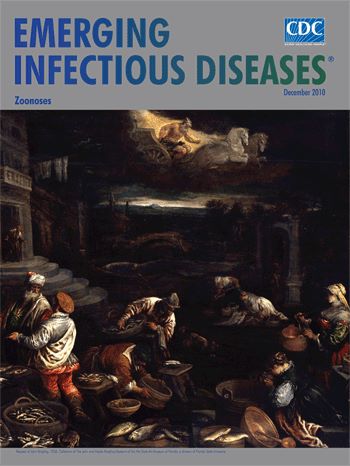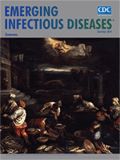
EID Journal Home > Volume 16, Number 12–December 2010
Volume 16, Number 12–December 2010
MEDSCAPE CME ACTIVITY
Oseltamivir-Resistant Pandemic (H1N1) 2009 Virus, South Korea
Medscape, LLC is pleased to provide online continuing medical education (CME) for this journal article, allowing clinicians the opportunity to earn CME credit. This activity has been planned and implemented in accordance with the Essential Areas and policies of the Accreditation Council for Continuing Medical Education through the joint sponsorship of Medscape, LLC and Emerging Infectious Diseases. Medscape, LLC is accredited by the ACCME to provide continuing medical education for physicians. Medscape, LLC designates this educational activity for a maximum of 0.25 AMA PRA Category 1 Credits™. Physicians should only claim credit commensurate with the extent of their participation in the activity. All other clinicians completing this activity will be issued a certificate of participation. To participate in this journal CME activity: (1) review the learning objectives and author disclosures; (2) study the education content; (3) take the post-test and/or complete the evaluation at www.medscapecme.com/journal/eid; (4) view/print certificate.
Learning Objectives
Upon completion of this activity, participants will be able to:
* Describe the pattern and characteristics of resistance seen with antiviral agents in pandemic (H1N1) 2009 in South Korea.
Medscape CME Editor [Contact us at eideditor@cdc.gov]
Thomas J. Gryczan, MS, Technical Writer/Editor, Emerging Infectious Diseases. Disclosure: Thomas J. Gryczan, MS, has disclosed no relevant financial relationships.
Medscape CME Author
Desiree Lie, MD, MSEd, Clinical Professor; Director of Research and Faculty Development, Department of Family Medicine, University of California, Irvine at Orange. Disclosure: Désirée Lie, MD, MSEd, has disclosed the following relevant financial relationship: served as a nonproduct speaker for "Topics in Health" for Merck Speaker Services.
Authors
Disclosures: Hwajung Yi, PhD; Joo-Yeon Lee, PhD; Eun-Hye Hong, BS; Mi-Seon Kim, BS; Donghyok Kwon, MS; Jang-Hoon Choi, MS; Woo-Young Choi, PhD; Ki-Soon Kim, PhD; Jong-Koo Lee, MD; Hee-Bok Oh, PhD; and Chun Kang, MS, have disclosed no relevant financial relationships.
Click here to continue to article:
Oseltamivir-Resistant Pandemic (H1N1) 2009 Virus, CME Activity | CDC EID

EID Journal Home > Volume 16, Number 12–December 2010
Volume 16, Number 12–December 2010
Dispatch
Oseltamivir-Resistant Pandemic (H1N1) 2009 Virus, South Korea
Hwajung Yi, Joo-Yeon Lee, Eun-Hye Hong, Mi-Seon Kim, Donghyok Kwon, Jang-Hoon Choi, Woo-Young Choi, Ki-Soon Kim, Jong-Koo Lee, Hee-Bok Oh, and Chun Kang Comments to Author
Author affiliation: Korea Centers for Disease Control and Prevention, Seoul, South Korea
Suggested citation for this article
Abstract
To identify oseltamivir resistance, we analyzed neuraminidase H275Y mutations in samples from 10 patients infected with pandemic (H1N1) 2009 virus in South Korea who had influenza that was refractory to antiviral treatment with this drug. A neuraminidase I117M mutation that might influence oseltamivir susceptibility was detected in sequential specimens from 1 patient.
Since April 2009, pandemic (H1N1) 2009 has spread worldwide and caused the first influenza pandemic of the 21st century. Pandemic (H1N1) 2009 virus initially showed resistance to amantadine but susceptibility to oseltamivir (1). Thereafter, 285 cases of oseltamivir-resistant pandemic viral infection were reported worldwide on April 14, 2010 (2). However, information is limited about oseltamivir-resistant pandemic influenza in South Korea. Monitoring of community circulation of oseltamivir-resistant viruses has not yet detected any evidence of oseltamivir resistance in South Korea. To identify these viruses, we conducted specific surveillance of antiviral drug–resistant infection in patients whose illness did not resolve after antiviral treatment.
The Study
The study was reviewed and approved by ethics committees of relevant institutions and hospitals. After patients provided informed consent, we obtained >150 clinical specimens from patients in various hospitals in South Korea. Respiratory specimens (>60% nasopharyngeal swab specimens) were obtained during October 2009–January 2010 from patients whose illness had been clinically refractory to antiviral treatment since October 2009.
Viral RNAs were isolated from specimens of 10 patients (Table 1) by using the QIAamp viral RNA Mini Kit (QIAGEN, Crawley, UK). PCR products of the neuraminidase (NA) and matrix 2 (M2) genes were generated by reverse transcription–PCR with primers for NA (forward: 5′-AAATTAACGGGCAATTCCTCTCT-3′; reverse: 5′-CCGAAAATCCCACTGCATATGTAT-3′) and M2 (forward: 5′-CTAGCTCCAGTGCTGGTCTGA-3′; reverse: 5′-CTCAGGCACTCCTTCCGTAGA-3′). DNA sequences of NA and M2 reverse transcription–PCR products were analyzed by using the Big-Dye Terminator Sequencing Reaction Kit and an ABI 3700 DNA analyzer (Applied Biosystems, Foster City, CA, USA). A total of 58 NA sequences and 52 M2 sequences were obtained and analyzed by using the sequence analysis tool in the Influenza Sequences and Epitopes Database for detecting oseltamivir-resistance mutations (3).
Ten patients were detected who had oseltamivir-resistant pandemic (H1N1) 2009 virus with the H275Y substitution in viral NA (Table 2). Oseltamivir resistance was associated with oseltamivir treatment on the basis of H275Y changes from the oseltamivir-sensitive genotypes to oseltamivir-resistant genotypes of viral NA in consecutive samples from the same patient. Furthermore, a novel NA (I117M) substitution that may be associated with oseltamivir resistance (4,5) was detected in specimens from 1 patient (patient G) who had myelodysplasia and received oseltamivir and peramivir (Tables 1, 2).
In addition, we cultured viral isolates from clinical specimens (patients A and C) and evaluated antiviral susceptibility by measuring the dose of oseltamivir and zanamivir required for 50% inhibition (IC50) of NA activity. One isolate of pandemic (H1N1) 2009 virus with an oseltamivir-sensitive genotype (H275 in its NA) was susceptible to oseltamivir (IC50 1.18 nmol/L) and zanamivir (IC50 0.42 nmol/L). Viral isolates from patients A and C with an oseltamivir-resistant genotype (Y275 in NA) were resistant only to oseltamivir (IC50 713.2 nmol/L and 359.4 nmol/L, respectively). Susceptibility to zanamivir was not altered whether NA contained Y275 or H275 (IC50 0.13 nmol/L and 0.78 nmol/L, respectively).
Patients with oseltamivir-resistant pandemic (H1N1) 2009 were treated during hospitalization with oseltamivir alone or with a combination of other antiviral drugs (Table 2). Active surveillance that evaluated spread of oseltamivir-resistant viral infections among hospital staff, family members, and other patients who had contacted with or cared for the patients showed no evidence of virus transmission in the hospitals
full-text:
Oseltamivir-Resistant Pandemic (H1N1) 2009 Virus | CDC EID
Suggested Citation for this Article
Y Hi, Lee J-Y, Hong E-H, Kim M-S, Kwon D, Choi J-H, et al. Oseltamivir-resistant pandemic (H1N1) 2009 virus, South Korea. Emerg Infect Dis [serial on the Internet]. 2010 Dec [date cited]. http://www.cdc.gov/EID/content/16/12/1938.htm
DOI: 10.3201/eid1612.100600
Comments to the Authors
Please use the form below to submit correspondence to the authors or contact them at the following address:
Chun Kang, Division of Influenza Viruses, Center for Infectious Diseases, National Institute of Health, Korea Centers for Disease Control and Prevention, Nokbeon-dong, Eunpyeong-gu, Seoul, 122–701, South Korea; email:ckang@nih.go.kr


































No hay comentarios:
Publicar un comentario